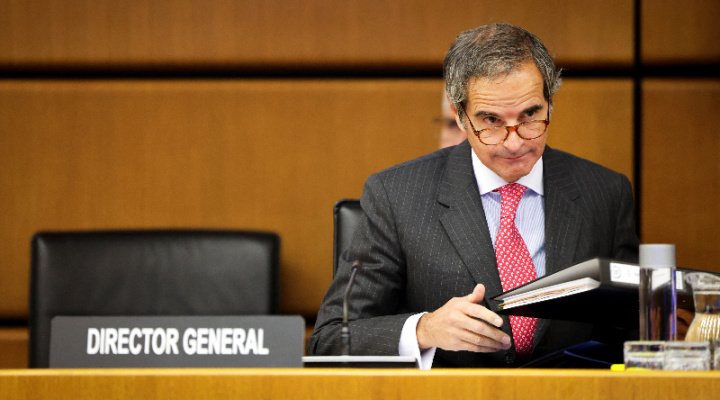International Atomic Energy Agency (IAEA) Director General Rafael Grossi arrives on the opening day of the agency’s quarterly Board of Governors meeting at the IAEA headquarters in Vienna, Austria, Nov. 20, 2024. Photo: REUTERS/Lisa Leutner
There is a chance that much of Iran’s highly enriched uranium survived Israeli and US attacks because it may have been moved by Tehran soon after the first strikes, UN nuclear watchdog chief Rafael Grossi said on Wednesday.
Israel repeatedly struck Iranian nuclear facilities during its 12-day war with Tehran, and US forces bombed Iran’s underground nuclear facilities at the weekend, but the extent of the damage to its stocks of enriched uranium is unclear.
International Atomic Energy Agency chief Grossi said earlier this week that Iran had informed the IAEA on June 13 – the first day of Israeli strikes – that it would take “special measures” to protect its nuclear materials and equipment.
“They did not get into details as to what that meant but clearly that was the implicit meaning of that, so we can imagine that this material is there,” Grossi told a press conference on Wednesday with members of the Austrian government.
“So, for that, to confirm, for the whole situation, evaluation, we need to return [IAEA inspectors to Iran’s nuclear facilities].”
He said ensuring the resumption of IAEA inspections was his top priority as none had taken place since the bombing began although Iran’s parliament approved moves on Wednesday to suspend such inspections.
The IAEA needs to determine how much remains of Iran’s stock of uranium enriched to up to 60 percent purity – a level that is close to the roughly 90 percent of weapons grade.
Uranium enrichment has both civilian and military applications. Iran has always denied seeking nuclear weapons and says its nuclear program is solely for peaceful purposes.
The IAEA says no other country has enriched to such a high level without producing nuclear weapons, and Western powers say there is no civil justification for it.
‘HOURGLASS APPROACH’
The last quarterly IAEA report on May 31 indicated that Iran had, according to an IAEA yardstick, enough uranium enriched to up to 60 percent purity for nine nuclear weapons if enriched further. It has enough for more bombs at lower enrichment levels such as 20 percent and 5 percent, the report showed.
A preliminary US intelligence assessment determined that the US strikes at the weekend set back Tehran’s program by only a matter of months, meaning Iran could restart its nuclear program in that time, three sources with knowledge of the matter told Reuters on Tuesday.
“This hourglass approach is something I do not like … It’s in the eye of the beholder,” Grossi said.
“When you look at the … reconstruction of the infrastructure, it’s not impossible. First, there has been some that survived the attacks, and then this is work that Iran knows how to do. It would take some time.”
Iranian Foreign Minister Abbas Araqchi said on Tuesday that Tehran’s view on the nuclear program and the non-proliferation regime would now “witness changes, but it is not possible to say in what direction.”
Iran’s parliament approved a bill on Wednesday on suspending cooperation with the IAEA and stipulating that any future IAEA inspection would need approval by Iran’s Supreme National Security Council. The bill still requires approval by Iran’s unelected Guardian Council to become law.
Parliament Speaker Mohammad Baqer Qalibaf was quoted by state media as saying the IAEA “has put its international credibility up for sale” and that Iran would accelerate its civilian nuclear program.
“This would be, of course, very regrettable,” Grossi said of Iran’s threat to withdraw from the nuclear Non-Proliferation Treaty (NPT).
“I hope this is not the case. I don’t think this would help anybody, starting with Iran. This would lead to isolation and all sorts of problems and, why not, perhaps, if not the unravelling a very, very, very serious erosion in the NPT structure,” he said.
The post UN Nuclear Chief Says It’s Possible Iran’s Highly Enriched Uranium ‘Is There’ first appeared on Algemeiner.com.
Click this link for the original source of this article.
Author: Reuters and Algemeiner Staff
This content is courtesy of, and owned and copyrighted by, https://www.algemeiner.com and its author. This content is made available by use of the public RSS feed offered by the host site and is used for educational purposes only. If you are the author or represent the host site and would like this content removed now and in the future, please contact USSANews.com using the email address in the Contact page found in the website menu.








